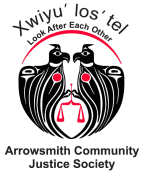
Restorative Justice
A Focus on Repairing Harm & Restoring Relationships
Restorative justice philosophy focuses on repairing harm and restoring relationships by empowering those who go through the process to have a voice. Although individual programs can differ in how the process is delivered, the philosophy remains intact.

Restorative Justice
A Focus on Repairing Harm & Restoring Relationships
Restorative justice philosophy focuses on repairing harm and restoring relationships by empowering those who go through the process to have a voice. Although individual programs can differ in how the process is delivered, the philosophy remains intact.


A Focus on Repairing Harm & Restoring Relationships
Restorative justice philosophy focuses on repairing harm and restoring relationships by empowering those who go through the process to have a voice. Although individual programs can differ in how the process is delivered, the philosophy remains intact.


A Focus on Repairing Harm & Restoring Relationships
Restorative justice philosophy focuses on repairing harm and restoring relationships by empowering those who go through the process to have a voice. Although individual programs can differ in how the process is delivered, the philosophy remains intact.
What is Restorative Justice?
(RJ)
Restorative Justice (RJ) is a way of thinking about and responding to a crime as primarily a violation against people and relationships.
Alternatively, the Canadian justice system views and responds to crime almost exclusively as an act of law-breaking against the Crown. RJ enables the coming together of the person(s) having caused the harm, the person(s) affected by that harm, and the larger community as facilitator, to create a meaningful, healing solution.
In other words, RJ focuses on repairing the harm and restoring relationships in the community. It is essential to the process that the person having caused the harm takes full responsibility for their actions, to access RJ.
What is Restorative Justice? (RJ)
Restorative Justice (RJ) is a way of thinking about and responding to a crime as primarily a violation against people and relationships.
Alternatively, the Canadian justice system views and responds to crime almost exclusively as an act of law-breaking against the Crown. RJ enables the coming together of the person(s) having caused the harm, the person(s) affected by that harm, and the larger community as facilitator, to create a meaningful, healing solution.
In other words, RJ focuses on repairing the harm and restoring relationships in the community. It is essential to the process that the person having caused the harm takes full responsibility for their actions, to access RJ.
Traditional Justice System
-
Crown and community set punishments for crime
-
Offender is punished
-
Crime is considered act of individual responsibility
-
Based on the belief that the threat of punishment is a deterrent
-
Victims are peripheral (often absent) from the process
-
Offender is defined by deficits, with focus on establishing blame or guilt in adversarial relationship between victim and offender
-
Imposition of punishment (pain) in order to deter/prevent future such actions
-
Community sidelined – represented in an abstract way by the Crown
Restorative Justice
-
Victims, Offenders and their support people develop a mutually satisfying repair
-
Offender is accountable by assuming responsibility and working to repair the harm
-
Crime has both individual and social dimensions of responsibility
-
Punishment alone is not considered to be effective in changing behaviour, when it is in fact disruptive to community harmony and good relationships
-
Victims are central to the process
-
Offender is defined by capacity to express empathy and regret, and to make reparation
-
Focus is on problem solving, liabilities/obligations, and future: what can be done to move forward
-
Community sidelined – represented in an abstract way by the Crown
Commonly quoted and accepted definition of RJ:
A process whereby parties with a stake in a specific offense resolve collectively
how to deal with the aftermath of the offense and its implications for the future.
how to deal with the aftermath of the offense and its implications for the future.
Traditional Justice System
-
Crown and community set punishments for crime
-
Offender is punished
-
Crime is considered act of individual responsibility
-
Based on the belief that the threat of punishment is a deterrent
-
Victims are peripheral (often absent) from the process
-
Offender is defined by deficits, with focus on establishing blame or guilt in adversarial relationship between victim and offender
-
Imposition of punishment (pain) in order to deter/prevent future such actions
-
Community sidelined – represented in an abstract way by the Crown
Restorative Justice
-
Victims, Offenders and their support people develop a mutually satisfying repair
-
Offender is accountable by assuming responsibility and working to repair the harm
-
Crime has both individual and social dimensions of responsibility
-
Punishment alone is not considered to be effective in changing behaviour, when it is in fact disruptive to community harmony and good relationships
-
Victims are central to the process
-
Offender is defined by capacity to express empathy and regret, and to make reparation
-
Focus is on problem solving, liabilities/obligations, and future: what can be done to move forward
-
Community sidelined – represented in an abstract way by the Crown
Commonly quoted and accepted definition of RJ:
A process whereby parties with a stake in a specific offense resolve collectively
how to deal with the aftermath of the offense and its implications for the future.
how to deal with the aftermath of the offense and its implications for the future.
Benefits of the Restorative Justice Approach
Research studies show there are many benefits to participating in the restorative justice process when compared to the traditional court process.
Saves Time & Money
Referrals are effectively dealt with in a cost-effective and timely manner outside the court system.
Equal Opportunity
All parties affected by an incident have a voice in the process, and can provide input when determining a resolution.
Promotes Resolutions
Increased probability of reaching resolution, and decreased probability of reoffending.
Involves Closure
Participants experience a sense of closure throughout the process.
Applies Reflection
Ability to become more aware of how one’s actions affect others, and an opportunity to take responsibility for those actions.
Promotes Community
By “looking after each other” we create a healthier and safer community for all.
Benefits of the Restorative Justice Approach
Research studies show there are many benefits to participating in the restorative justice process when compared to the traditional court process.
Saves Time & Money
Referrals are effectively dealt with in a cost-effective and timely manner outside the court system.
Equal Opportunity
All parties affected by an incident have a voice in the process, and can provide input when determining a resolution.
Promotes Resolutions
Increased probability of reaching resolution, and decreased probability of reoffending.
Involves Closure
Participants experience a sense of closure throughout the process.
Applies Reflection
Ability to become more aware of how one’s actions affect others, and an opportunity to take responsibility for those actions.
Promotes Community
By “looking after each other” we create a healthier and safer community for all.
CONTACT
Contact Arrowsmith Community Justice Society
If you would like to learn more about the restorative justice philosophy, check the resource link at the top of this page, and/or contact us with more specific questions.
CONTACT
Contact Arrowsmith Community
Justice Society
Justice Society
If you would like to learn more about the restorative justice philosophy, check the resource link at the top of this page, and/or contact us with more specific questions.
CONTACT
Contact Arrowsmith Community
Justice Society
Justice Society
If you would like to learn more about the restorative justice philosophy, check the resource link at the top of this page, and/or contact us with more specific questions.
